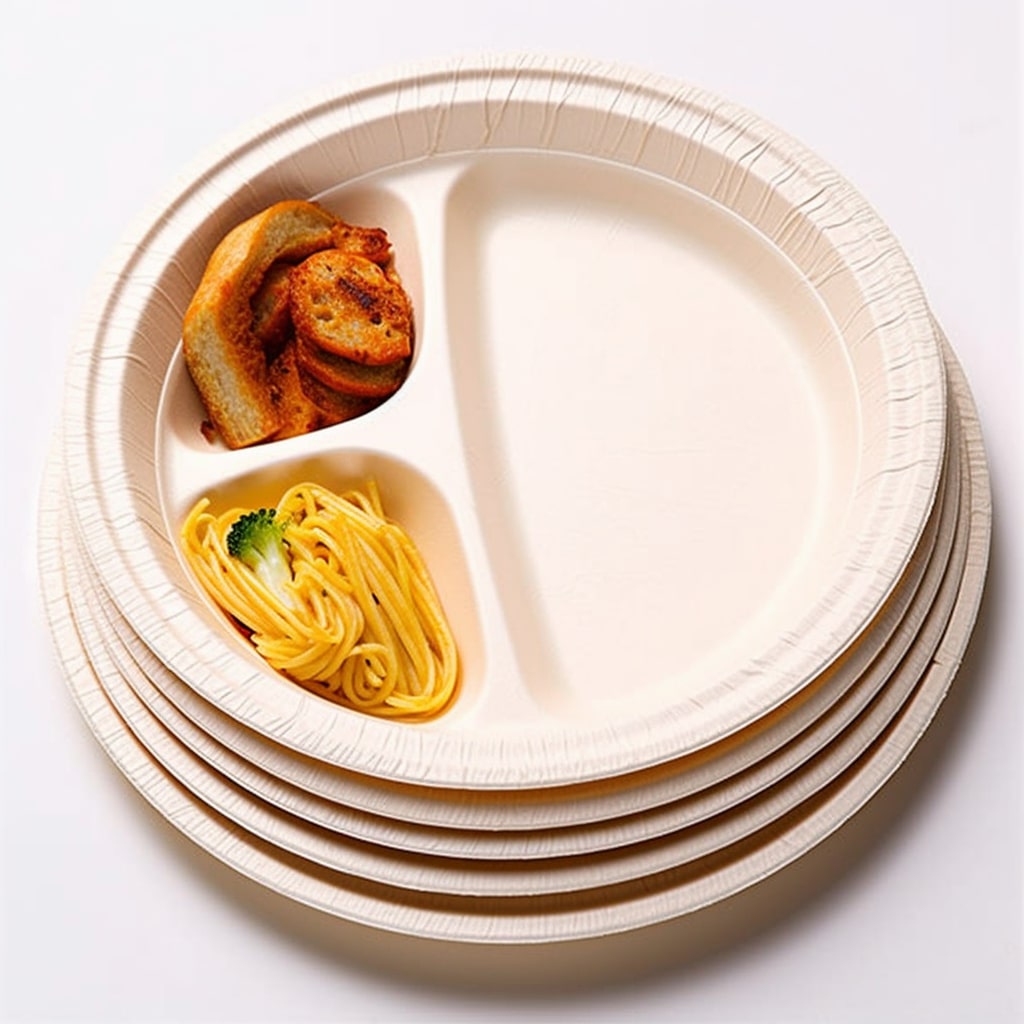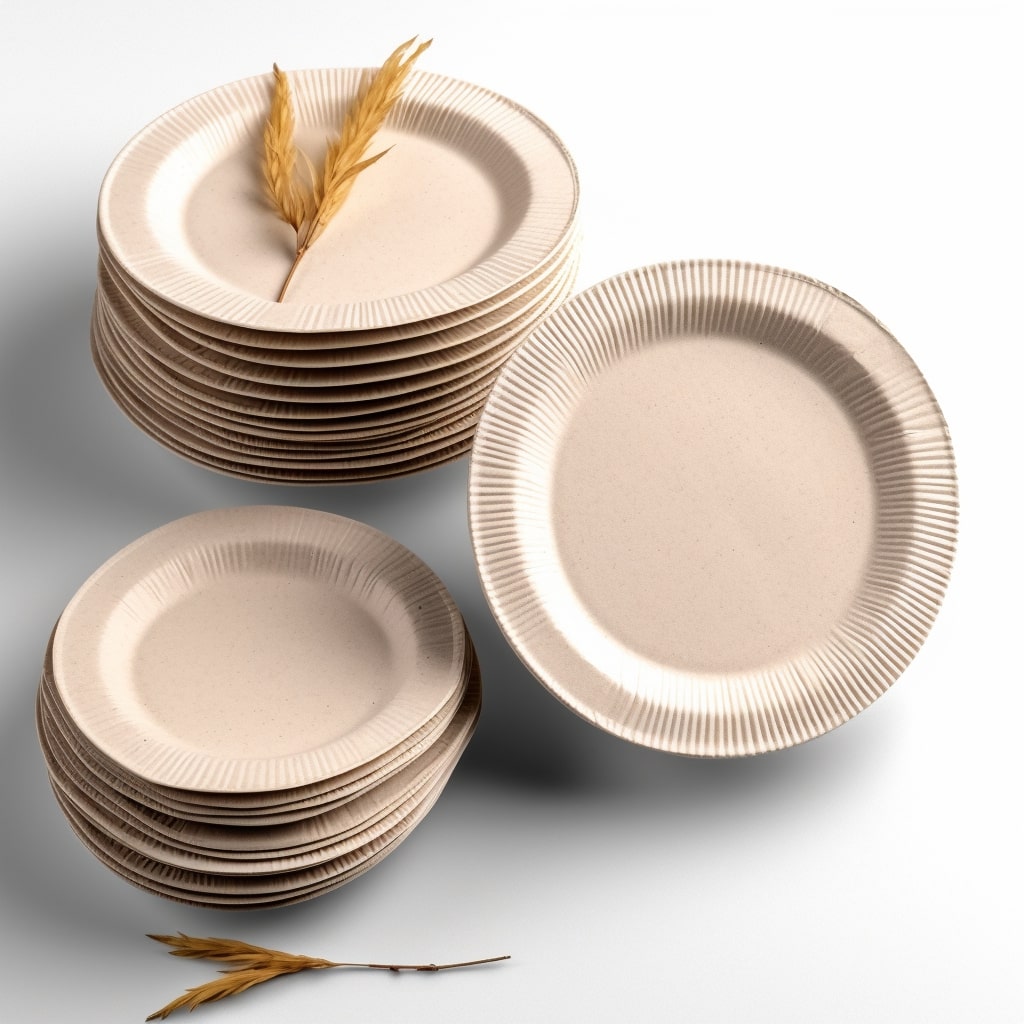Bamboo plates have gained popularity in recent years as a potentially eco-friendly alternative to traditional disposable plates. As concerns about the environmental impact of plastic and paper products continue to rise, consumers are seeking sustainable alternatives that minimize harm to the planet.
This article examines whether bamboo plates can be considered truly eco-friendly by analyzing various factors such as their production process, biodegradability, manufacturing techniques, carbon footprint, and end-of-life options.
To determine the eco-friendliness of bamboo plates, it is essential to assess their entire lifecycle. This includes evaluating their environmental impact from raw material extraction to disposal.
By examining key aspects such as the carbon emissions associated with production, chemical treatments used during manufacturing processes, and end-of-life options like composting or recycling, we can gain a clear understanding of whether bamboo plates align with your sustainability goals.
Key Takeaways
- Bamboo plates have two main end-of-life options: composting and recycling.
- Composting bamboo plates breaks them down into nutrient-rich compost for soil enrichment.
- Bamboo plates cannot be recycled through traditional recycling programs, but specialized facilities may accept them for recycling if they have the necessary equipment.
- Proper waste management through composting or recycling bamboo plates promotes environmental sustainability and reduces reliance on plastic-based alternatives.
Environmental Impact of Bamboo Production
The environmental impact of bamboo production is an important consideration when evaluating the eco-friendliness of bamboo plates.
Water Consumption
One aspect to examine is water consumption. Bamboo plants require a significant amount of water to grow, and this can put pressure on local water resources in regions where bamboo cultivation is prominent. However, compared to other crops like cotton or corn, bamboo requires relatively little water for its growth. Additionally, some studies have shown that bamboo can actually help improve soil moisture levels by enhancing water retention capacity due to its extensive root system.
Deforestation
Another factor to consider is deforestation. The demand for bamboo products has led to an increase in bamboo plantations and the conversion of natural forests into monoculture bamboo stands. This raises concerns about deforestation and habitat loss for wildlife species that may rely on these forests.
On the other hand, bamboo cultivation can reduce the impact on forests because of its potential as a substitute for wood and timber products. It should also be noted that unlike hardwood trees, which take decades or even centuries to grow back once harvested, bamboo grows rapidly and can be harvested within three to five years without killing the entire plant. This quick regrowth makes it a more sustainable alternative and reduces the pressure on natural forest ecosystems.
Carbon absorption
Bamboo is notable not only for its minimal negatives compared to alternatives, but it also has positive environmental attributes. In particular, the cultivation of bamboo plants helps reduce carbon dioxide levels in the atmosphere as they absorb more greenhouse gasses than most other plants. Therefore, using bamboo as a material for making plates not only reduces reliance on non-renewable resources but also contributes positively to combating climate change.
Overall, bamboo remains a relatively eco-friendly material compared to other options. Its minimal water requirements, rapid regrowth rate and carbon absorption capacities contribute positively towards its sustainability profile.
To ensure the eco-friendliness of bamboo plates further, it is essential for responsible cultivation practices and sustainable management of plantations to be implemented in order to minimize any negative impacts on local ecosystems.
End of Life Options: Biodegradability and Compostability of Bamboo Plates
End of life options are important factors to consider when evaluating the total environmental impact of bamboo plates.
Bamboo plates are known for their biodegradable properties, meaning they can break down naturally into organic materials without causing harm to the environment. This is a significant benefit compared to non-biodegradable alternatives such as plastic or styrofoam plates which can persist in landfill for hundreds of years.

The biodegradability of bamboo plates ensures that once disposed of, they will not contribute to long-term pollution.
Manufacturing Processes and Chemical Treatments
Manufacturing processes and chemical treatments play a crucial role in the production of sustainable alternatives to traditional disposable tableware. When it comes to bamboo plates, these processes and treatments can affect their overall durability, as well as determine whether they are truly eco-friendly.
The manufacturing process can greatly impact the strength and longevity of bamboo plates. Some manufacturers may use chemical treatments or additives to enhance the durability of bamboo products. While these treatments may increase the lifespan of the plates, they can also introduce potentially harmful substances into the environment when disposed of. Therefore, it is essential for manufacturers to prioritize (and for consumers to demand) eco-friendly practices and non-toxic treatments that do not compromise the biodegradability and compostability of bamboo plates.
As we seek alternative materials for eco-friendly plates, it is important to compare their environmental impact with that of traditional disposable tableware made from materials like plastic or Styrofoam. Below is a comparison table highlighting key aspects related to manufacturing processes and environmental considerations:
| Materials | Manufacturing Processes | Chemical Treatments | Biodegradability |
| Bamboo | Sustainable harvesting | Non-toxic additives | Yes |
| Plastic | Extraction & refining | Chemical additives | No |
| Styrofoam | Petroleum-based synthesis | None | No |
This table serves as a simplified overview illustrating how bamboo stands out as an environmentally friendly option compared to plastic or Styrofoam due to its sustainable harvesting methods, use of non-toxic additives during manufacturing, and inherent biodegradability. Manufacturers should focus on minimizing chemical treatments while ensuring the long-lasting quality of bamboo plates in order to provide truly eco-friendly alternatives to traditional disposable tableware.
Comparing the Lifecycle Carbon Footprint
To reduce carbon emissions throughout the lifecycle of bamboo plates, various strategies can be implemented. Firstly, sustainable harvesting practices can be employed during the cultivation of bamboo. This involves selectively cutting mature stalks while leaving younger ones intact for future growth.



Additionally, efficient manufacturing processes that minimize energy consumption and waste generation can further reduce carbon emissions. Transportation also plays a significant role in determining the overall carbon footprint of bamboo plates. By sourcing bamboo locally or regionally and using eco-friendly transportation options such as rail or ship instead of air freight, emissions related to transportation can be significantly reduced.
When comparing the lifecycle carbon footprints of different materials used for disposable tableware, bamboo plates appear to have potential sustainability advantages over plastic or paper alternatives. However, it is essential to implement carbon emissions reduction strategies throughout all stages of production and distribution in order to maximize their environmental benefits.
Sustainable harvesting practices, efficient manufacturing processes, and thoughtful transportation choices can contribute towards minimizing the carbon footprint associated with bamboo plate production and use.
Considering the End-of-Life Options
Considering the end-of-life options for disposable tableware materials is crucial in determining their overall environmental impact. Waste management plays a significant role in promoting environmental sustainability and reducing the carbon footprint associated with these products.
In the case of bamboo plates, there are two main end-of-life options to consider:
- Composting: Bamboo plates are often marketed as compostable due to their organic nature. When disposed of correctly, they can break down into nutrient-rich compost that can be used to enrich soil and support plant growth. This option is environmentally friendly as it reduces waste going to landfills and provides a sustainable solution for disposing of bamboo plates.
- Recycling: While bamboo plates are biodegradable, they cannot be recycled through traditional recycling programs. However, some specialized facilities may accept bamboo products for recycling if they have the necessary equipment to process them effectively. Recycling bamboo plates would involve separating the cellulose fibers from other components, such as additives or coatings, and repurposing them into new products.
Considering these end-of-life options highlights the importance of proper waste management when using eco-friendly disposable tableware like bamboo plates. By composting or recycling these materials, we can minimize waste generation and contribute towards a more sustainable approach to food service operations.
Conclusion
In conclusion, the eco-friendliness of bamboo plates depends on various factors.
The production of bamboo has a lower environmental impact compared to other materials such as plastic or paper due to its fast growth and minimal need for pesticides. Additionally, bamboo is biodegradable and compostable, making it a more sustainable option for disposable plates.
However, the manufacturing processes and chemical treatments used in producing bamboo plates can affect their overall eco-friendliness. It is important to consider how the bamboo is processed and whether any harmful chemicals are used during production. Opting for plates that are manufactured using eco-friendly practices and without the use of toxic substances can further enhance their sustainability.
Furthermore, when assessing the carbon footprint of bamboo plates throughout their lifecycle, including transportation and disposal methods, they generally have a lower impact compared to other alternatives like plastic or paper. However, it is crucial to consider the end-of-life options for bamboo plates. Proper disposal through composting or recycling ensures that they can be effectively reused or returned to nature without causing harm.
Overall, while being mindful of manufacturing processes and end-of-life options, choosing bamboo plates can be an environmentally friendly choice due to their renewable nature, biodegradability, and low carbon footprint. Incorporating these sustainable alternatives into our daily lives contributes positively towards reducing our environmental impact.

